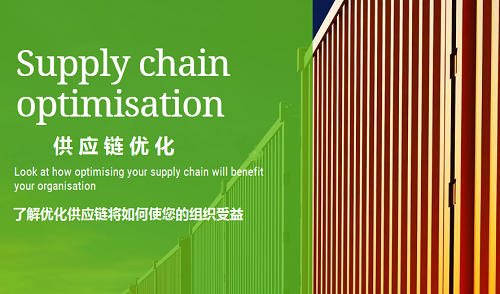- 【学习贴】CIPS视角看供应链优化
- 发布时间:2023-08-02 11:26:37 阅读次数:246

What does supply chain optimisation mean?
Supply chain optimisation (SCO) is the application of tools and processes to streamline an end-to-end manufacturing or production operation. The aim of it is to reduce cost and increase profit.
供应链优化 (SCO) 是应用工具和流程来简化端到端制造或生产运营。其目的是降低成本,增加利润。When working in the supply chain, you’re tasked with seeking optimisation. You must try to find a balance of delivering what the customer wants at the lowest overall cost, but with the highest overall profit to your business.
在供应链中工作时,您的任务是寻求优化。您必须努力找到平衡点,以最低的总体成本交付客户所需的产品,同时为您的企业带来最高的总体利润。What are the four attributes of supply chain?
The supply chain can be broken down into four key attributes:
供应链可以分为四个关键属性:
1)Integration: This starts in your planning stage and is the key to long-term success. Make sure you have an accurate and reliable source of information about your supply chain activities, which helps you to plan for and mitigate supply issues.
整合:这从您的规划阶段开始,是长期成功的关键。确保您拥有有关供应链活动的准确可靠的信息来源,这有助于您规划和缓解供应问题。2)Operations: The day-to-day running of your operations is important to maintain a strong supply chain.
运营:日常运营对于维持强大的供应链非常重要。3)Procurement: This is the sourcing, contract and supplier relationship management aspect of securing goods, services and works for the organisation.
采购:这是为组织确保货物、服务和工程的采购、合同和供应商关系管理方面。4)Distribution: This is where the supply chain ends, when the product or serviced is delivered to the customer.
分销:这是供应链结束的地方,即产品或服务交付给客户时。
What is the goal of supply chain optimisation?
供应链优化的目标是什么?
The goal of SCO is to remove waste activities and add value to your supply chain process, without increasing your risk or reducing your efficiency or the product availability to the customer.
SCO 的目标是消除浪费活动并为您的供应链流程增加价值,而不增加您的风险或降低您的效率或客户的产品可用性。How do you optimise a supply chain?
Every link in the supply chain costs money and takes time to improve it. When improved, you can reduce the amount of money that link costs. Here are some opportunities to consider for optimisation.
供应链中的每个环节都需要花钱并且需要时间来改进。改进后,您可以减少链接成本。以下是一些需要考虑的优化机会。1)Mapping the supply chain: To improve the supply chain, understand the current structure and where the blockages and costs lie. An in-depth mapping process will expose these areas.
绘制供应链图:为了改善供应链,了解当前的结构以及障碍和成本所在。深入的绘图过程将暴露这些区域。2)Improved business alignment: Align your supply chain to the organisational structure strategy and goals. Align management resources to support the supply chain objectives e.g., people, information, technology, finance. Align suppliers with your supply chain goals through communication and collaboration.
改善业务一致性:使您的供应链与组织结构战略和目标保持一致。调整管理资源以支持供应链目标,例如人员、信息、技术、财务。通过沟通和协作,使供应商与您的供应链目标保持一致。3)Software support: Introduce mathematical modelling software to plot optimal inventory holding against customer demand. This can either be integrated in a central ERP system or run by an application service provider (ASP) as a bespoke service.
软件支持:引入数学建模软件,根据客户需求绘制最佳库存持有量。这可以集成到中央 ERP 系统中,也可以由应用程序服务提供商 (ASP) 作为定制服务运行。4)Improved processes: Introduce lean and agile approaches. Collaborative planning, forecasting and replenishment routines. Business process re-engineering. Outsourcing non-core activities to third party providers. Reduce manual processes e.g., Introduce block chain technology in invoicing and payments.
改进流程:引入精益和敏捷方法。协作规划、预测和补货例程。业务流程重组。将非核心活动外包给第三方提供商。减少人工流程,例如在发票和支付中引入区块链技术。5)Pursuing specific supply chain optimisation opportunities: For example, improved order processing, reduced inventory, warehouse and storage management, freight handling, increased supplier collaboration, focused reporting and analytics, security, transportation and logistics, compliance and auditing, product size and packaging, innovative production approaches.
追求特定的供应链优化机会:例如,改进订单处理、减少库存、仓库和仓储管理、货运处理、加强供应商协作、重点报告和分析、安全、运输和物流、合规和审计、产品尺寸和包装、创新生产方式。6)Waste reduction: Look at delays, bottlenecks, double handling, write offs and remove all these non-value adding activities.
减少浪费:查看延误、瓶颈、双重处理、核销并消除所有这些非增值活动。7)Introducing measurement and Key Performance Indicators: Measure the impact of your optimisation approaches by use of Gross Margin Return on Inventory Invested (GMROII), Standard Deviation and Means Absolute Deviation on stock, Cash Flow indicators and Working capital measures.
引入测量和关键绩效指标:通过使用投资库存毛利率回报 (GMROII)、库存标准差和均值绝对偏差、现金流量指标和营运资本测量来测量优化方法的影响。
—文章来源CIPS
点击报名








